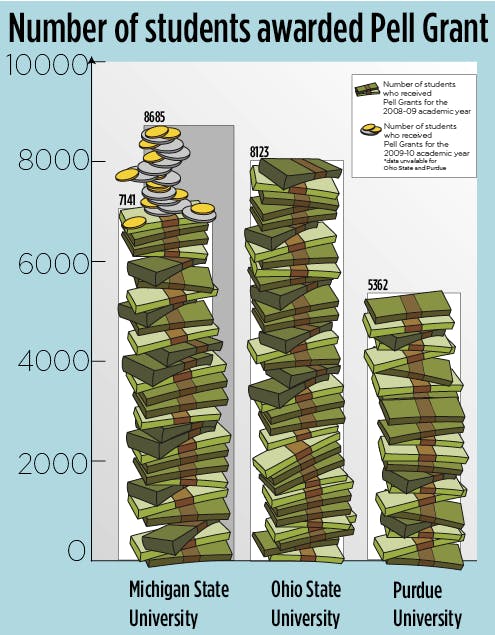Among the nation’s wealthiest schools, MSU stands out in terms of some aspects of the financial aid they distribute.
MSU specifically ranks high in terms of the amount of Pell Grants they distribute to undergraduate students, according to recent data from the Department of Education. About 18.8 percent of all MSU undergraduate students enrolled for the full year received Pell Grants in 2008-09, a statistic that ranks MSU fourth in the country among 50 schools who received the highest Pell Grant endowments, according to the department.
Pell Grants are funded and operated through a federal government program initially implemented in the 1970s. The grants provide need-based aid to eligible students, most often from low-income families.
Nationwide, about 6.2 million students received Pell Grants in 2008-09. Of that amount, about 19.5 percent of those grants were distributed to students with a family income level of between $20,001 to $30,000, according to data from the National Association of Student Financial Aid Administrators, or NASFAA.
Although the university distributed Pell Grants to more than 7,000 students in 2008-09 and more than 8,600 in 2009-10, the future of the program’s funding is uncertain, said Val Meyers, associate director in the MSU Office of Financial Aid.
“It is very hard right now. … The question is, ‘will they be able to continue to fund the Pell Grants at the current level or will there be cuts?’” she said. “That’s a question we can’t answer yet.”
By the numbers
The actual appropriations received by the university in terms of Pell Grant funding have increased recently, Meyers said. Conversely, MSU increased the number of students who received aid between 2004-05 and 2008-09 from 17.9 percent to 18.8 percent. That figure represents a jump of about 488 students.
In all, MSU paid out more than $39.3 million in Pell Grants to 8,685 students across the 2009-10 school year.
“It has gone through some different adjustments,” Meyers said. “Prior to that, they were very flat.”
Zoology senior Trish Eddie is among the thousands of students who recently received Pell Grants through MSU. Eddie has received the grants since the beginning of last summer.
“I have actually read about MSU being one of the top schools that offers things like that,” she said. “I think they do a really good job just as far as providing extra grants because they offer extra grants besides what the Pell Grant offers.”
The criteria for distribution has changed.
From 2007-08 to this past year, the maximum grant payment ceiling was raised from $4,533 to $5,550, according to NASFAA data. On average, MSU distributes about $4,536 per Pell Grant. That amount then is divided up between fall and spring semesters, Meyers said.
The funding increase at MSU also reflects a spike in appropriations distributed across the country.
The amount the federal government distributed to universities for Pell Grants between 2007-08 and 2009-10 jumped from about $15.1 billion to about $28.2 billion, the NASFAA reported.
Out of those funds, 28 percent of all Pell Grant endowments in 2008-09 were distributed to public four-year institutions such as MSU.
MSU on the rise
Despite the increase in appropriations across the country, some universities did not distribute the funds accordingly.
Out of 20 schools who distribute Pell Grants to the highest percentages of students, only six — including MSU — actually gave Pell Grants to a higher percentage of students in 2008-09 than in 2004-05.
As that figure has increased, the number of students appealing for aid at MSU also has increased, Meyers said.
“The reasons that we’re basically looking at for appeals are loss of employment,” she said. “If you or your parents had employment in the tax year but now one of your parents has lost a job or cut back in hours, that would be a big reason for appeal.”
Support student media!
Please consider donating to The State News and help fund the future of journalism.
At Purdue University, about 216 fewer students received Pell Grants between 2004-05 and 2008-09. However from 2009-10 to 2010-11, more than 1,000 additional students received some form of the grants, said Joyce Hall, executive director of the Division of Financial Aid at Purdue.
“That (increase) was due in part to changes in eligibility but also the economic downturn,” Hall said.
Purdue distributed Pell Grants to roughly 15.4 percent of all eligible undergraduate students in 2008-09. Throughout the rest of the Big Ten, Ohio State University gave out some form of the grants to 17.8 percent of undergraduate students — a figure that puts them just behind MSU — while the University of Wisconsin-Madison distributed the aid to 10.5 percent of enrolled members.
Going forward
MSU is open to accepting applications for Pell Grants throughout the year on a rolling basis, Meyers said.
The amount of incoming students who will receive Pell Grants for this fall is not known, she said.
Changing federal criteria — based primarily off of family income benchmarks — will continue to allow more students to be eligible for the grants in the future.
Under those criteria, MSU has a high number of grant-eligible students, Meyers said.
However, pressures from the federal budget crunch could change the program’s outlook, particularly at MSU, economics professor Charles Ballard said.
“MSU and the other 14 state universities that receive aid from the state have seen huge reductions in the money they get from the state,” Ballard said. “It’s not just Pell Grants.”
Meyers said MSU’s commitment to distributing Pell Grants to students has been successful despite the changing economic climate.
“It means that we’re fulfilling our land grant mission,” she said. “MSU’s land grant mission is to serve the diverse people of the state of Michigan — it means we’re doing that.”
Discussion
Share and discuss “MSU among leaders in giving” on social media.

